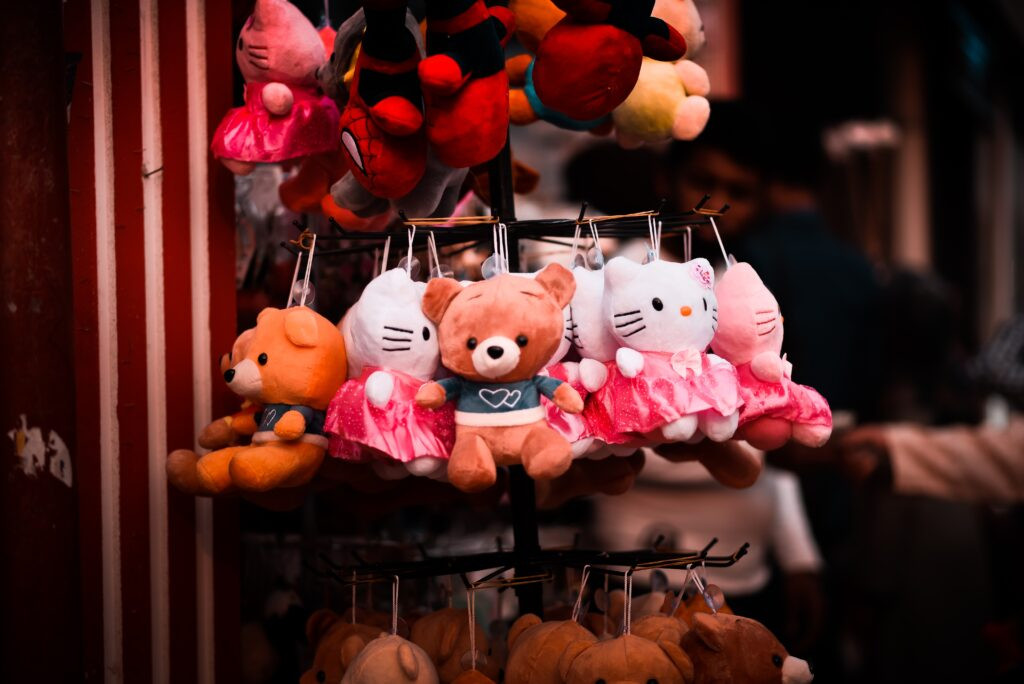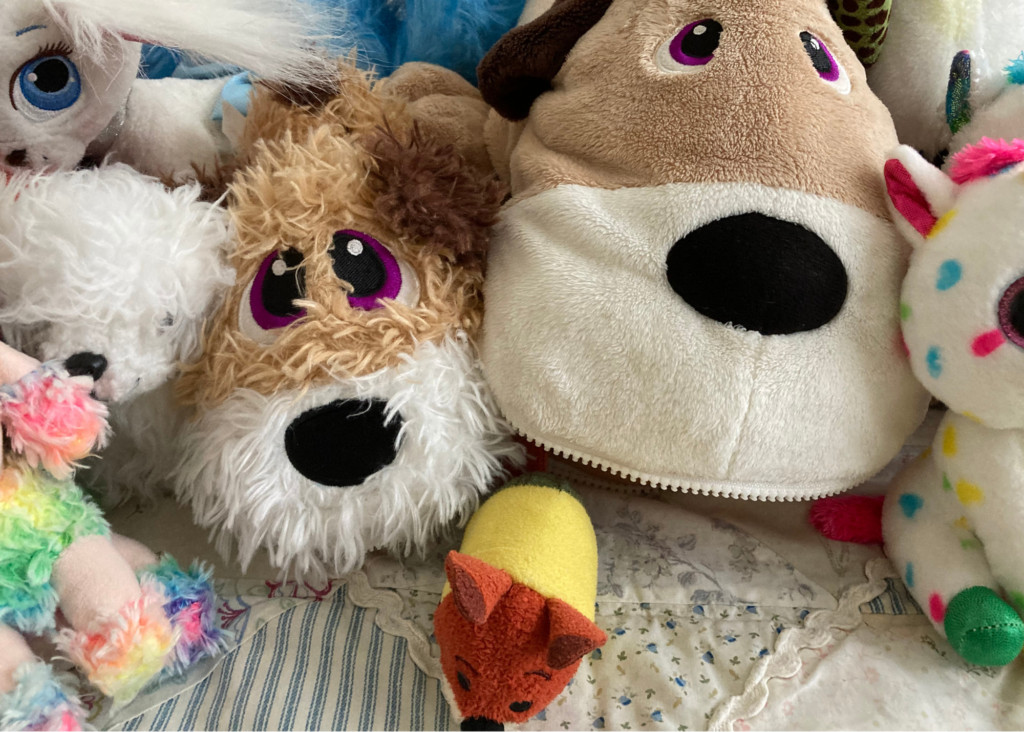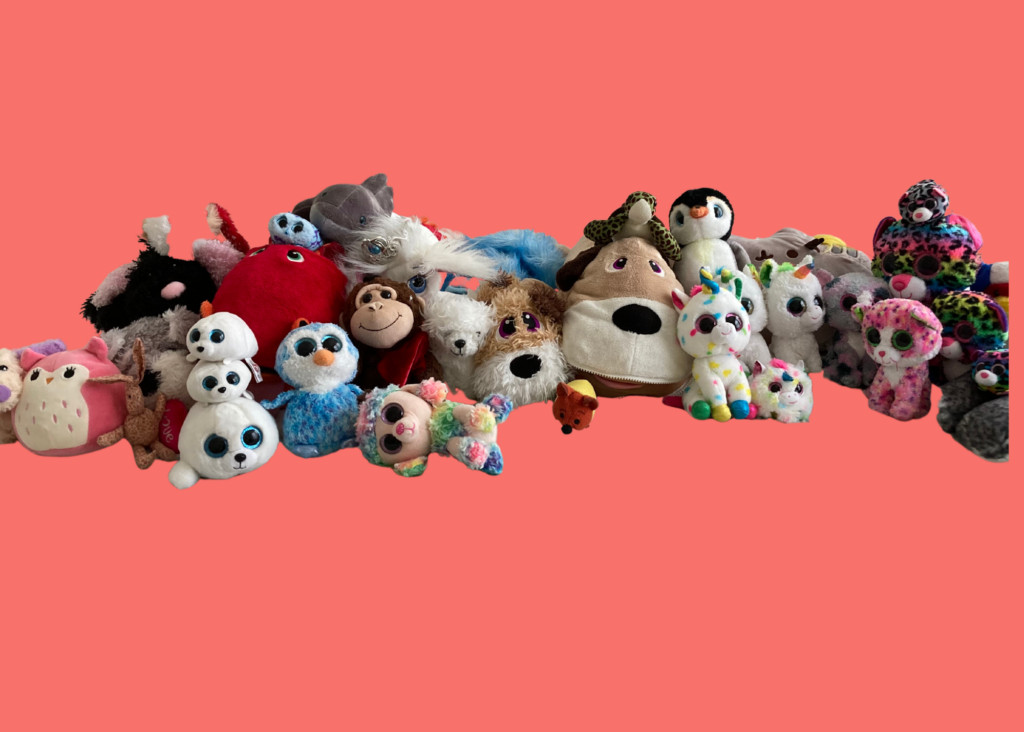Navigating the world of decluttering, especially when kids are involved, often feels like an emotional rollercoaster. One particular challenge many parents face is the ever-growing mountain of stuffed animals. Like many families, our home became a haven for cuddly creatures. It started innocently enough – a cute penguin from Kohl’s, a memorable squeaky toy from a trip, and a collection of rainbow unicorns amassed over birthdays and holidays. Before we knew it, these plush companions had multiplied, taking over bedrooms and hearts alike.
The Plush Toy Overload: A Common Parent Dilemma

Alt text: Overflowing basket of colorful stuffed animals, illustrating the common problem of plush toy accumulation in homes.
It’s hard to resist those adorable faces in stores, and saying “no” to adding another soft friend to the family can feel like a parental fail. The joy these toys brought to my children was undeniable. However, the sheer volume eventually became overwhelming. Stuffed animals migrated from toy bins to under beds, cluttered closet shelves, and even invaded our adult sanctuary, the master bedroom. The daily tidying battles became tiresome, and honestly, I suspected my daughter had lost track of half her collection under the plush pile-up.
While she wasn’t quite ready for a full-scale stuffed animal exodus, I knew we needed to thin the herd. The idea of quietly rehoming some of the less cherished toys crossed my mind, but the potential for sentimental landmines was too high. Instead, I opted for a gradual approach. A large plastic bag became the temporary holding zone for overlooked plushies. This bag moved from corner to corner for months, even years. Then, one day, my daughter rediscovered the bag, a nostalgic smile touched her lips as she glanced at her forgotten friends, and then, without a backward glance, she moved on. It was a poignant moment, a subtle signal that perhaps, the time for letting go was approaching.
The Unexpected Hurdle: Finding Donation Centers for Used Toys
With the emotional hurdle cleared, I thought the practical part would be simple. I envisioned local charities and donation centers eagerly accepting gently used toys, ready to give them a new lease on life. Reality, however, delivered a surprising twist. Researching places that accept used stuffed animals revealed a frustrating truth: many organizations, while appreciative of donations, often have strict policies favoring new items only.
The thought of these well-loved toys ending up in a thrift store, potentially destined for flea markets or discount bins, didn’t sit right. I yearned for a more meaningful destination – a children’s hospital, a women’s shelter, or a Ronald McDonald House, places where these cuddly companions could bring comfort and joy to children in need.

Alt text: A variety of plush toys arranged neatly on a shelf, representing the desire to find a good home for donated stuffed animals.
My minimalist sensibilities wrestled with a touch of embarrassment. I knew we had excess, and I knew it was time for these plush friends to find new homes and create new memories. But the desire to donate responsibly, to ensure they went somewhere impactful, proved to be more challenging than anticipated. Many of the local charities I contacted had policies restricting donations to only new toys, leaving me searching for alternatives. Just when I was about to give up, I discovered a fantastic solution.
Stuffed Animals for Emergencies: A Premier Donation Pathway

Alt text: Logo for Stuffed Animals for Emergencies (SAFE), highlighting it as a key resource for stuffed animal donations.
Stuffed Animals for Emergencies (SAFE) emerged as the ideal answer to my donation dilemma. This incredible website acts as a central hub, connecting donors with local charities and organizations across the country that actively welcome donations of gently used stuffed animals. SAFE simplifies the process, allowing you to pinpoint organizations in your area or choose a cause that resonates with you. They provide clear and easy-to-follow guidelines on how to prepare your plush toys for donation, ensuring they are clean and ready to bring comfort to children facing challenging circumstances. The preparation steps are straightforward: a gentle cleaning with mild detergent, thorough drying (either in a dryer on a gentle cycle or air-drying after wiping with a damp cloth and soapy water). Detailed instructions are readily available on their website, ensuring your donations meet hygiene standards.
For our family, donating to an orphanage listed on the SAFE website felt particularly meaningful. My grandfather’s history as a passenger on an orphan train from New York added a personal connection to this cause. While some donation locations might be within driving distance, offering the convenience of local drop-off, we were drawn to the orphanage, even if it meant shipping was required.
The donation process itself was simple. After washing the stuffed animals with hypoallergenic laundry detergent (the same we use for our family’s clothing) and ensuring they were completely dry, we arranged them for a group photo. The organization appreciates these photos to track the volume of donations and share the impact with their network. For me, these pictures also served as a sweet way to document a significant part of my daughter’s childhood journey with her beloved plush companions.
Packing the cleaned and photographed stuffed animals into boxes was the final step before sending them off. While the shipping costs were a factor, especially considering the number of toys we were donating, the peace of mind knowing they were going to a deserving cause made it worthwhile. SAFE provided the most direct and fulfilling way to ensure our stuffed animals would be used, appreciated, and hopefully, deeply loved by children who needed them most.
The Emotional Release: More Than Just Toys

Alt text: A child hugging a stuffed animal tightly, symbolizing the comfort and emotional connection children have with plush toys.
Donating those stuffed animals evoked a surprisingly strong emotional response, akin to parting with baby clothes and other cherished childhood mementos. Memories flooded back with each plush toy – the twin unicorn set, the rainbow cheetah family, and the collection of “Stuffies” that both my children had adored during their early years.
Despite the sentimental pangs, there was also a sense of relief and satisfaction. I’m not a fan of clutter, and knowing these toys were no longer gathering dust but embarking on a new adventure was comforting. My daughter’s easy acceptance of their departure further validated our decision. We had, of course, carefully curated a selection of her absolute favorites to remain with us, ensuring her most treasured plush companions stayed safely home.
Ultimately, letting go of the stuffed animals was less about decluttering physical items and more about acknowledging a passing phase in my daughter’s life, and in my own journey as a parent. These weren’t just stuffed dogs and unicorns; they represented a precious chapter of childhood. Donating them was a gentle lesson in letting go, a bittersweet but necessary step in moving forward, while ensuring these comforting companions could bring joy to other children in need.
Exploring Additional Donation Avenues
While Stuffed Animals for Emergencies proved to be the most effective solution for our family, numerous other options exist for donating stuffed animals. Consider reaching out to local organizations in your community. Fire departments and police stations often keep stuffed animals on hand to comfort children in distress. Religious organizations and social services agencies are also frequently in need of donations for families they support. Exploring these local avenues can provide even more direct ways to give your gently used stuffed animals a meaningful second life within your community.


